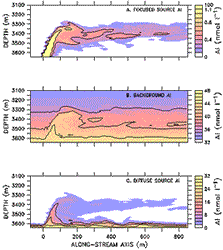Buoyant plumes in cross flows
Diffuse
venting and background contributions to chemical anomalies in a neutrally
buoyant ocean hydrothermal plume (Abstract)
Problem
Description:
High-temperature,
focused venting leads to significant vertical mixing and redistribution
of tracers in the benthic ocean. Vent discharge and background benthic
water entrained into a plume lead to altered geochemical and microbial
payloads found well above the seafloor. Take the case of aluminum. Observations
in the Atlantic show Al profiles naturally enhanced near bottom. That
is caused by Al rich particles settling to the sea floor and the subsequent
remobilization of elemental AL. But diffuse hydrothermal flows also introduce
Al to the near-bottom waters surrounding high temperature vents. A question
to be answered is how focused, diffuse, and background sources of Al all
contribute to Al levels in neutrally buoyant plumes. This study looks at
Al distributions at the TransAtlantic Geotraverse (TAG) site in the Atlantic
using one- and three- dimensional models of convective plumes. Contributions
of the background and diffuse Al fields dominante.
 |
Vertical (x-z) sections along the flow direction and though the TAG mound for each source component species: a)
Al from focused sources, click for larger view FLI
Animation (1.1 mb) |
|
Related
Papers: Chronic
focused-source plumes Lavelle, J.W. (1997): Buoyancy-driven plumes in rotating, stratified cross flows: Plume dependence on rotation, turbulent mixing, and cross-flow strength. Journal of Geophysical Research, 102(C2), 3405-3420. Geochemical Transport
|
||
| Modeling focuses: Chronic focused-source | Event Plumes | Axial Valley transport | Ridge Flow | Geochemical Transport | Hydrographic-Tracer Relationships | ||
